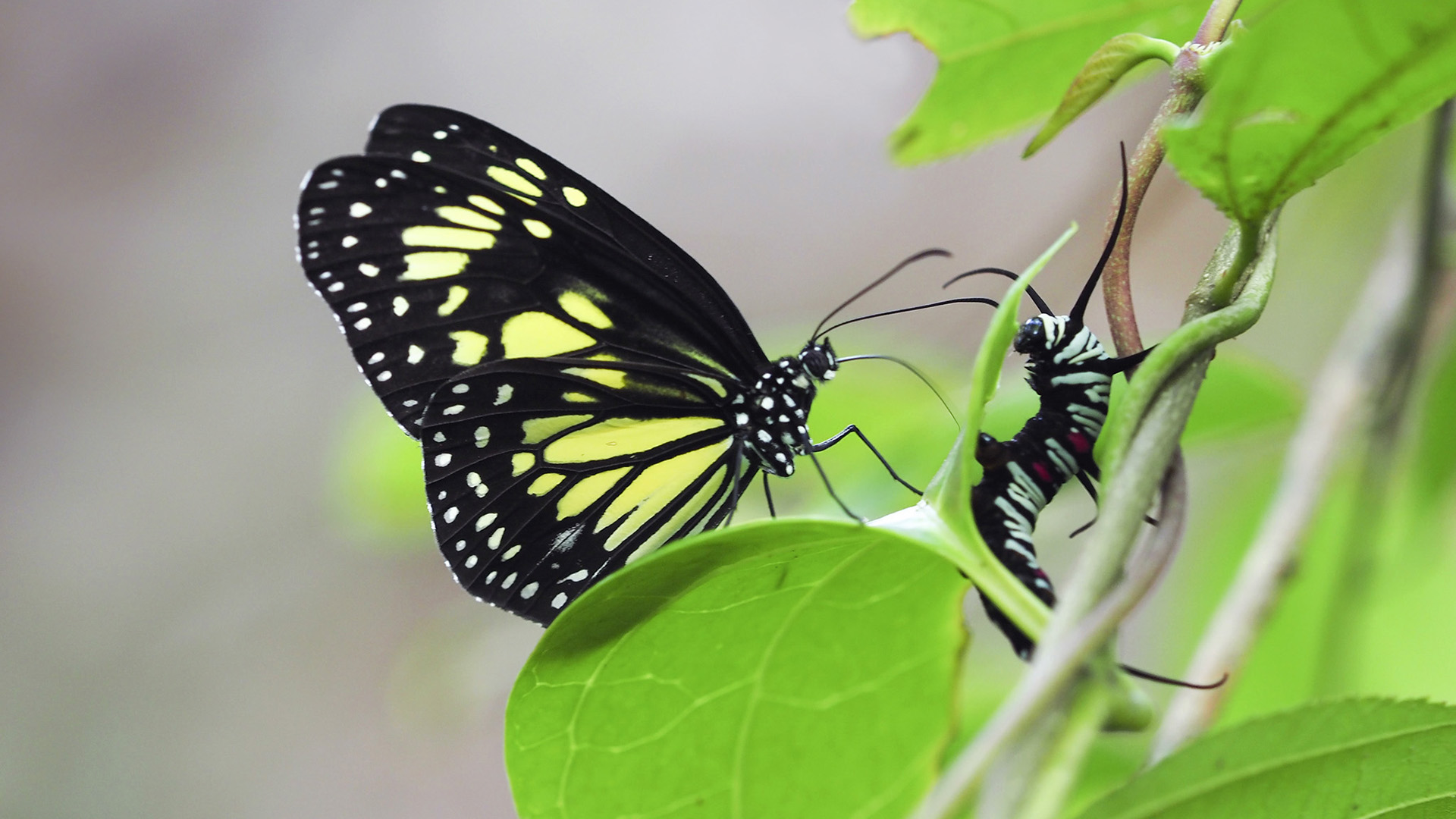Milkweed butterflies tear open caterpillars and drink them alive
This is the first time scientists have documented the grisly behavior.

Not all caterpillars grow up to be beautiful butterflies. Some become living milkshakes for their dads, who guzzle caterpillar body fluids to attract the ladies.
Recently, scientists reported the first evidence of butterflies sipping from the bodies of caterpillars — dead and alive. They observed adult milkweed butterflies in North Sulawesi, Indonesia, using tiny claws on their feet to scratch wounds in caterpillars' bodies so they could lap the liquid that oozed out.
Male butterflies seek certain compounds produced by milkweed (flowering plants in the family Apocynaceae), which repel predators and help the butterflies produce pheromones that attract females. Since caterpillars are stuffed with juices from chewed-up plants, they make an easy target for butterflies looking to chemically boost their attractiveness to females.
Related: Photos: Butterflies snag goo from unwitting ants
"The caterpillar larvae would contort their bodies rapidly in what appeared to be futile attempts to deter the persistent scratching of adults," said the researchers who observed the butterfly baby-drinking. They described their observations in a study published Sept. 8 in the journal Ecology.
Butterflies in the Danainae family are known as milkweed butterflies because most of the caterpillars in this group feed on milkweed plants, which contain toxic alkaloids that are absorbed by the caterpillars and then processed into useful chemicals that protect them from predators. Another use for these alkaloids is in mating pheromones, which are transferred to females in the males' sperm packet "as a nuptial gift," the scientists wrote.
Most milkweed butterfly species are found in Asia, but four species live in North America, one of which is the colorful monarch butterfly (Danaus plexippus), according to the Digital Atlas of Idaho. Male butterflies in this family are known for a unique behavior called leaf-scratching, in which adults supplement the plant sap they absorbed as hungry caterpillars by scraping at milkweed leaves with their tiny claws to release alkaloid-loaded sap for drinking through their long proboscis. Sometimes males gather by the hundreds to scratch and sip on milkweed leaves, according to the study.
Get the world’s most fascinating discoveries delivered straight to your inbox.
But on Dec. 9, 2019, lead study author Yi-Kai Tea, a doctoral candidate in the University of Sydney's School of Life and Environmental Sciences, and co-author Jonathan Soong Wei, a naturalist in Singapore, saw milkweed butterflies in Indonesia's Tangkoko Batuangus Nature Reserve that were scratching at a different sap-loaded source: live milkweed caterpillars.
"Multiple adults were observed scratching many caterpillars along a stretch of coastal vegetation" that spanned more than 1,600 feet (500 meters), the researchers reported. They then saw the butterflies actively drink "from the wounded and oozing caterpillars" for hours, with the butterflies sometimes gathering in mixed-species groups. So intent were the butterflies on drinking from the caterpillars that not even the touch of a human observer could distract them, the study authors wrote. To describe the behavior, the scientists coined the term "kleptopharmacophagy," which means "consuming stolen chemicals."
"The alternative neologisms 'kairopharmacophagy' (feeding on defensive chemicals from wounded caterpillars detected via 'eavesdropping') or 'necropharmacophagy' (feeding on defensive chemicals from dead caterpillars) might also be appropriate," the researchers reported.
Over three days, the scientists counted seven species of milkweed butterflies that scraped and sipped living and dead caterpillars (it is unknown if the dead caterpillars were drunk to death or died of their wounds). One possible explanation for why the butterflies find caterpillars so delicious is because milkweed alkaloids accumulate in the caterpillars' bodies from the leaves that they eat, making their internal "juices" a more potent, alkaloid-rich brew — and thereby more attractive to thirsty males, the scientist suggested.
It's likely that the butterflies are drawn to milkweed leaves that are already damaged from caterpillar chewing; those caterpillars would be close by when the adults start scratching. If a butterfly accidentally scrapes a caterpillar, the wound would release a heady chemical scent that would attract the butterfly and encourage it to scratch the caterpillar even more, according to the study.
Many questions remain about this unusual (and ghastly) behavior, such as which specific plant compounds attract the butterflies to the caterpillars and do butterflies in other parts of the world also practice baby-drinking, Tea said in a statement.
"These simple observations raise questions about the ecology of these well-known butterflies, providing numerous opportunities for future studies," he said.
Originally published on Live Science.

Mindy Weisberger is a science journalist and author of "Rise of the Zombie Bugs: The Surprising Science of Parasitic Mind-Control" (Hopkins Press). She formerly edited for Scholastic and was a channel editor and senior writer for Live Science. She has reported on general science, covering climate change, paleontology, biology and space. Mindy studied film at Columbia University; prior to LS, she produced, wrote and directed media for the American Museum of Natural History in NYC. Her videos about dinosaurs, astrophysics, biodiversity and evolution appear in museums and science centers worldwide, earning awards such as the CINE Golden Eagle and the Communicator Award of Excellence. Her writing has also appeared in Scientific American, The Washington Post, How It Works Magazine and CNN.



